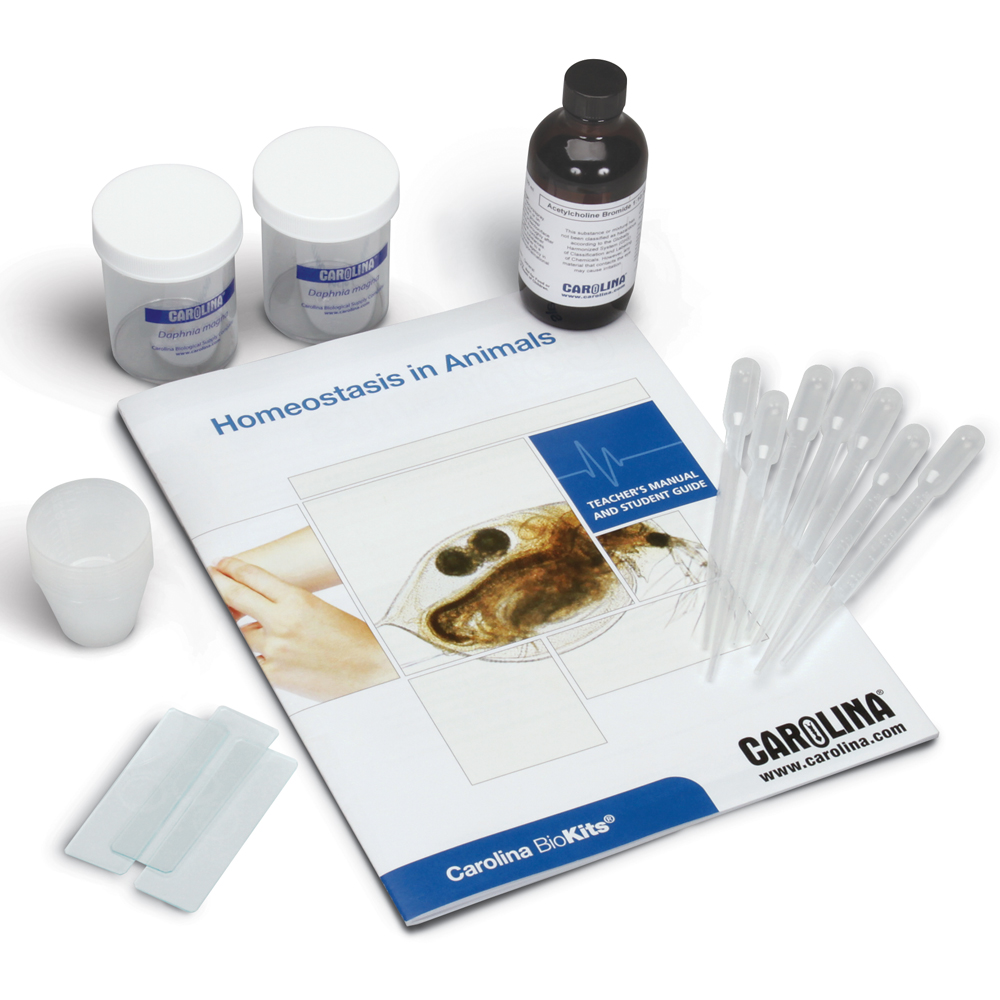Homeostasis in Animals
A Carolina EssentialsTM Activity

Total Time: 60-75 mins
Prep: 15 mins | Activity: 45-60 mins

Life Science
9-12
High School
- Total Time: 60-75 minutes [ Prep: 15 mins | Activity: 45-60 mins ]
- Subject: Life Science
- Grade: High School
Overview
This is an introductory activity to introduce students to the phenomenon of homeostasis. Students gather data on set point or resting heart rate, exercise, collect data again, and then relate the data to negative feedback mechanisms. Students visualize and explain homeostasis through graphing and graph interpretation. Minimal equipment is needed.
Essential Question
How do feedback mechanisms maintain homeostasis in animals?
Activity Objectives
- Determine set point, or normal resting heart rate.
- Using student data, identify and explain negative feedback mechanisms and the role they have in maintaining homeostasis.
Next Generation Science Standards* (NGSS)
HS-LS1-3. Plan and conduct an investigation to provide evidence that feedback mechanisms maintain homeostasis.
SCIENCE & ENGINEERING PRACTICES
Planning and Carrying Out Investigations
- Conduct an investigation individually and collaboratively to produce data to serve as the basis for evidence, and in the design: decide on types, how much, and accuracy of data needed to produce reliable measurements and consider limitations on the precision of the data (e.g., number of trials, cost, risk, time), and refine the design accordingly.
DISCIPLINARY CORE IDEA
LS1.A Structure and Function
- Feedback mechanisms maintain a living system’s internal conditions within certain limits and mediate behaviors, allowing it to remain alive and functional even as external conditions change within some range. Feedback mechanisms can encourage (through positive feedback) or discourage (negative feedback) what is going on inside the living system.
CROSSCUTTING CONCEPTS
Stability and Change
- Feedback (negative or positive) can stabilize or destabilize a system.
Materials
- 1 Time keeping device, such as a stopwatch, smart phone, or access to a clock per pair of students
Safety & Disposal
Make certain students are healthy enough to run in place for 2 minutes prior to beginning the activity. Use this activity only in accordance with established laboratory safety practices, including appropriate personal protective equipment (PPE) such as gloves, chemical splash goggles, and lab coats or aprons. Ensure that students understand and adhere to these practices. Students should not eat, drink, or chew gum in the lab and should wash their hands after entering and before exiting the lab.
There is no chemical disposal.
STUDENT PROCEDURES
- Lab partners will take turns as test subject and observer to determine the set point for the test subject’s resting heart rate.
- For each person in the lab group, determine the set point for resting heart rate by taking each person’s pulse 3 times for 15 seconds.
- Average the three 15-second values.
- Run in place for 2 minutes.
- Determine pulse rate for 15 seconds immediately after running.
- Take the pulse rate again for 15 seconds, at intervals of 1 minute, for a total of 5 minutes.
- Record data for each person in the group.
TEACHER PREPARATION AND TIPS
- Prior to beginning the activity, demonstrate how to find and take a pulse, both on the neck and on the wrist.
- Emphasize the importance of accurate timekeeping.
- If necessary, remind students that they will add the 3 resting pulse numbers and divide by 3 to get the average.
- Step 5 must happen quickly. Remind students to have the timekeeping device ready to record the 15 seconds.
- You may want to combine each group’s data and look at data from the whole class.
Data and Observations
Student answers will vary slightly but should be within normal range (60 to 100 beats/minute or 15 to 25 beats/15 seconds).
Resting Heart Rate

Post Exercise Heart Rate

Analysis & Discussion
Compare the set point heart rate for each group member
If students are healthy, the range of set point heart rates should not vary widely and will probably be within normal ranges. Students may notice slight differences between genders or athletes and nonathletes.
On the same axes, graph every group member’s average set point heart rate and post- exercise heart rates. Color code or label each line. On the graph, identify the set point, where exercise is taking place, and where corrective mechanisms are activated. Remember to title the graph, label the axes, include units, and include a key.

Using the concepts of homeostasis and negative feedback mechanisms, explain each segment of the graph.
Segment 1: The slope of the line segment is positive indicating an increase in heart rate. Exercise with an increased need for oxygen to the muscles, is the stimulus to which the circulatory must respond to maintain homeostasis.Segment 2: The slope of the line segment is negative indicating the circulatory system is in a self-correcting, negative feedback mechanism. Heart rate is coming down, returning the body to normal through the process of homeostasis.Segment 3: The slope of segment 3 is negative and very small indicating that the body is returning to set point heart rate and homeostasis is maintained.
If you collected data for a positive feedback mechanism, how would the graph change?
Segment 1: The slope of the line segment would be negative indicating a decrease in rate or amount. Segment 2: The slope of the line segment would be positive indicating a self-correcting, positive feedback mechanism. Segment 3: The slope of segment 3 would be positive and very small indicating that the body is returning to set point rate or amount and homeostasis is maintained.
Convert your heart rates to beats/min. Compare your heart rate to the normal range of 60-100 beats/min.
Energy flow was from the environment to the system. I know this because the temperature went down.

SHOP THE KIT
REFERENCE KITS
HELPFUL LINKS
VIEW MORE ESSENTIALS
*Next Generation Science Standards® is a registered trademark of Achieve. Neither Achieve nor the lead states and partners that developed the Next Generation Science Standards were involved in the production of, and do not endorse, these products.




